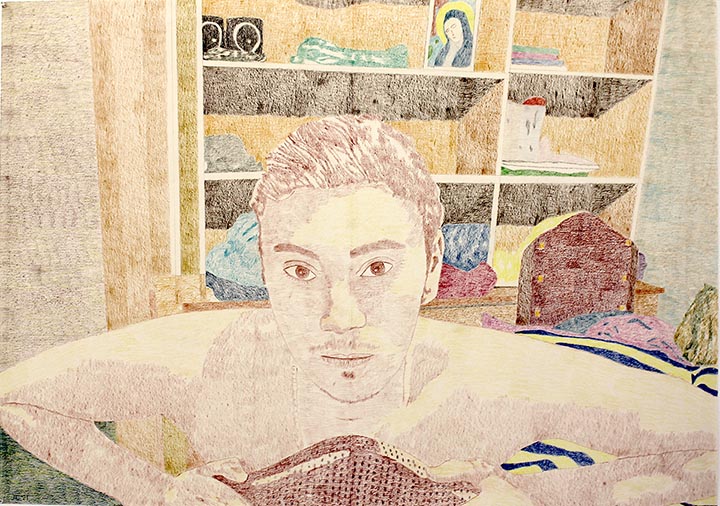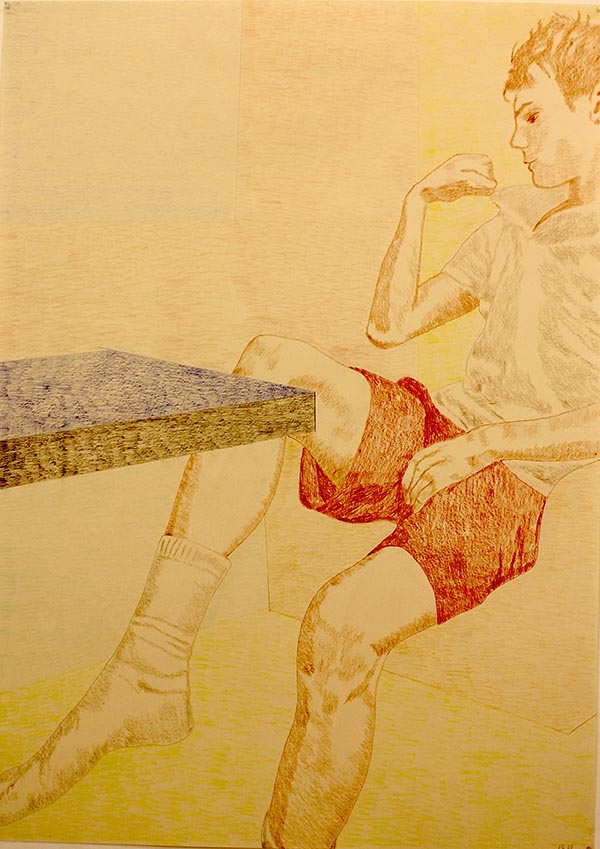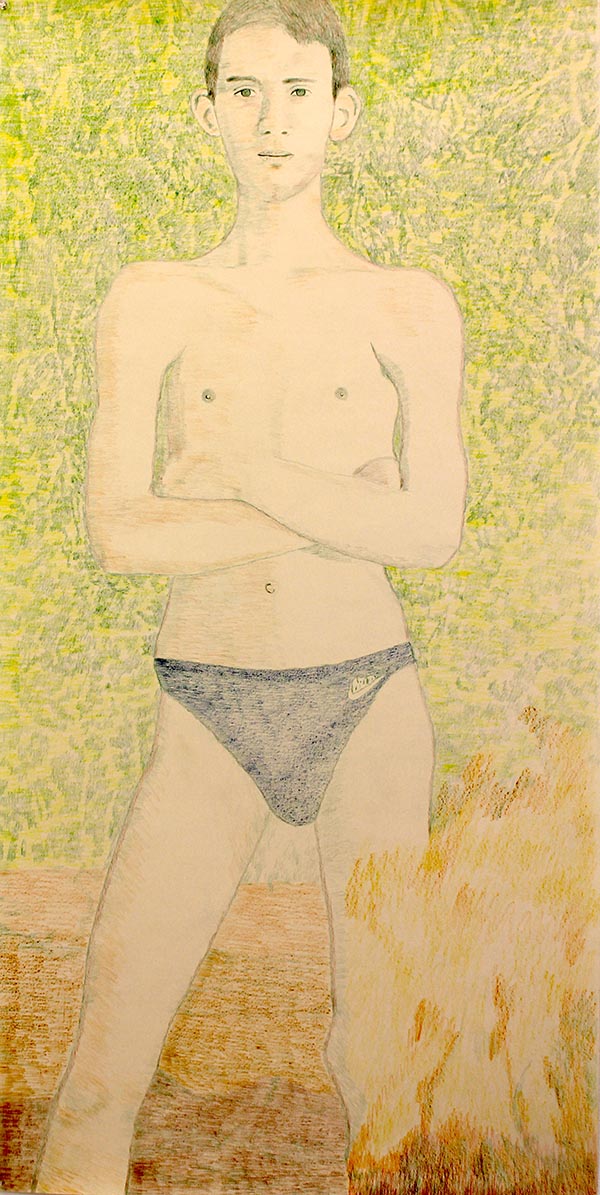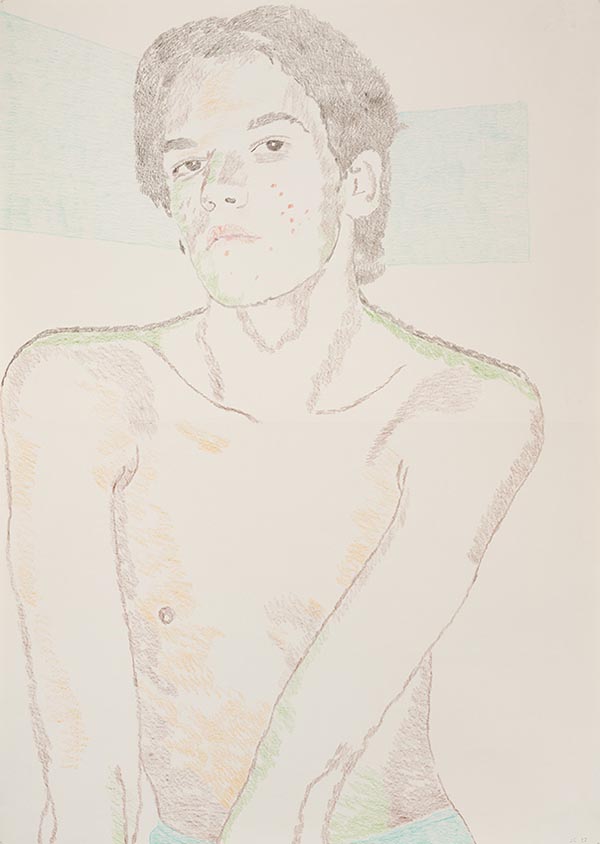
Jean Crotti, Sans titre, 2019. Crayon de couleur sur papier (tous), 140 x 70 cm. Photo: Claude-Hubert Tatot.
Jean Crotti – Crayon de couleur, ère numérique
Texte de Claude-Hubert Tatot – English text below
Jean Crotti fait varier un travail auquel il se tient et qui, au fil des années, ne perd rien de son caractère subversif. La première de ces subversions tient à l’usage du crayon de couleur qui même dans la patrie de Caran d’Ache est le plus souvent associé aux pratiques enfantines et scolaires qu’aux beaux-arts. C’est l’outil du coloriage, c’est aussi celui de deux autres artistes marquants, André Raffray qui a entre-autres copié des tableaux de maîtres avec cette technique et Pierre Klossowski dont certains grands dessins ont un caractère énigmatique et érotique.
Jean Crotti à des points communs avec l’un et l’autre. Lui aussi copie mais d’après selfies issus d’internet. Si la copie d’après l’antique à ses lettres de noblesse, le passage de l’écran au papier, de la photographie stéréotypée au dessin peut sembler triviale. C’est une manière de faire à verser au dossier déjà nourri des relations entre le pictural et la photographie. Comme Klossowski certaines images ont un caractère érotique.
A n’en pas douter ces jeunes hommes posent satisfaits d’eux même, un peu exhibitionnistes et parfois un poil vénaux. Leurs images circulent, se repostent de site en site et servent le plus souvent d’appâts pour quelques abonnements Only Fan ou effeuillages par écrans interposés contre token. Elles incitent à en voir toujours plus.
A l’inverse les dessins de Crotti en arrêtent la course. De l’égoportrait de téléphone diffusable et démultiplié en un clic il fait de grands portraits, œuvres originales sur papier, accrochées en ce moment aux murs de la galerie genevoise. En les faisant entrer dans le champ de l’art et de son histoire il transforme la nature de ces images, en montre finalement moins et surtout autrement. Il prend plus le risque d’exciter les senseurs qui se multiplient à tort et à travers que ceux qui viendraient se rincer l’œil et ils en ont vu d’autres.
La matérialité de l’œuvre est essentielle, elle rend ces images tangibles et uniques, leur donne du corps, du poids et de l’épaisseur. La trace visible du geste fait vibrer la couleur, témoigne d’une attention et d’un temps passé. Chaque grand format est fait en deux parties, deux feuilles traitées séparément, collées l’une à l’autre avec un peu de jeu dans le raccordement, indice supplémentaire du fait main.
Il faut s’attarder sur les dessins comme Crotti sur les images qu’il interprète. Alors apparaissent les circulations de couleur, un même bleu pour le motif d’un polo, la bordure de l’encolure, des manches courtes et les yeux, un jaune à la Bonnard qui vient éclairer un torse, un corps entier qui passe en gris bleu. Il y a aussi les verticales et les horizontales des fonds qui encadrent les corps et créent l’espace. Il y a les manques, les réalités éludées et encore les détails du décor, une icône, une statuette, une pendule et avec ces objets tout un univers qui s’ouvre, un hors champ qui fait du modèle un sujet et non pas seulement un objet de désir.
Claude-Hubert Tatot
Jean Crotti – Solo show
12 mai – 1er juillet 2023.
Skopia Art Contemporain
Rue des Vieux-Grenadiers 9. 1205 Genève
Jean Crotti, colored pencil, digital era
Jean Crotti varies a work to which he remains committed and which, over the years, loses none of its subversive character. The first of these subversions lies in the use of colored pencils, which, even in the homeland of Caran d’Ache, is most often associated with children and school practices rather than Fine Arts. It is the tool for coloring, and it is also the tool of two other significant artists, André Raffray, who, among other things, copied masterpieces using this technique, and Pierre Klossowski, whose large drawings have an enigmatic and erotic character.
Jean Crotti shares similarities with both of them. He also copies, but based on selfies taken from the internet. While copying from the antique has its noble heritage, the transition from the screen to paper, from stereotypical photography to drawing, may seem trivial. It is a way of working that adds to the already extensive dossier on the relationship between pictorial art and photography. Like Klossowski, some images have an erotic character.
Undoubtedly, these young men pose satisfied with themselves, a bit exhibitionistic, and sometimes a bit venal. Their images circulate, reposted from site to site, and most often serve as bait for a few OnlyFans subscriptions or screen-mediated stripteases in exchange for tokens. They encourage the desire to see more and more.
In contrast, Crotti’s drawings put a stop to this race. From the easily diffused and multiplied self-portrait on a phone, he creates large, original works on paper, currently hanging on the walls of Skopia Gallery. By bringing them into the realm of art and its history, he transforms the nature of these images, showing less of them and, above all, showing them differently. He takes more risks in arousing the censors that multiply here and there than those who would come to satisfy their curiosity, as they have seen it all before.
The materiality of the artwork is essential; it makes these images tangible and unique, giving them substance, weight, and depth. The visible traces of the artist’s gestures make the colors vibrate, bearing witness to attention and time spent. Each large format is created in two parts, two sheets treated separately, glued together with some free floating in the joining, an additional indication of the handmade nature.
One must linger on the drawings, just as Crotti lingers on the images he interprets. Then, the circulation of colors becomes apparent—a consistent blue for the pattern on a polo shirt, the border of the collar, short sleeves, and the eyes; a Bonnard-like yellow that illuminates a torso; an entire body rendered in gray-blue. There are also the vertical and horizontal backgrounds that frame the bodies and create space. There are the omissions, the eluded realities, and still, the details of the setting—an icon, a statuette, a clock—and with these objects, an entire universe opens up, an off-screen that transforms the model into a subject, not just an object of desire.
Claude-Hubert Tatot
Jean Crotti – Solo show
12 mai – 1er juillet 2023.
Skopia Art Contemporain
Rue des Vieux-Grenadiers 9. 1205 Genève




